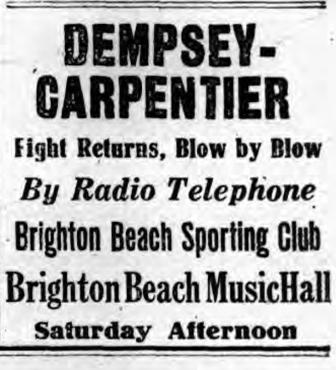Immeasurable Success
How Many People Listened?
At the time, the most conservative estimates of audience size gave a figure of 250,000 to 300,000. Certain recent estimates are significantly lower. Given that no one knew how many crystal radios existed, or how many people listened in their homes, or in those of their neighbors, it is impossible to know the actual number.
In terms of technology, most things worked well, although there were glitches. The New York Times had intended to connect loudspeakers directly to the broadcast, sending it booming across Times Square.
Times Square, July 2, 1921
Alas, before the main fight began, the connection between the loudspeakers and the radio signal failed. With no time to investigate the problem, the Times resorted to instead use telegraphed reports, which were read into microphones connected to the loudspeakers. At the time, the public probably was unaware of the change. In addition, staff posted reports in summary form on a billboard-like display mounted on the newspaper's building (see photograph above). Westinghouse relayed the broadcast input from Jersey City via wire to its station KDKA in Pittsburgh, but technical problems prevented its also relaying the signal to its as-yet unlicensed radio station in Newark.
There were some inherent factors that probably limited the size of the radio audience. Some newspapers carried advertisements that told readers about it, and advertised where people go to could hear the broadcast, but others refused, foreseeing that radio would become a threat to the newspaper industry.

Sign advertising the broadcast at
Loew's New York Theatre, June 28, 1921
https://earlyradiohistory.us/century2.htm

Brooklyn Standard Union
July 1, 1921
The use of a Navy broadcast frequency made things tricky. The Navy had, and needed to use, several radio frequencies for its blimp program. Which frequency would be expendable on the afternoon of the fight would depend on weather conditions, and on which blimps needed air time - factors which meant the decision had to be postponed as long as possible. Thus, it was not until the day before the fight that a choice was made, and only then could the frequency be announced to the press. As it would take time for novice listeners to locate the broadcast signal, and adjust their antennas and receivers appropriately, the broadcast would begin with a preliminary bout. This pre-broadcast gave listeners lots of time, which the radio novices in the audience definitely would need.
There were people who had not known of the broadcast in advance, but discovered it accidentally while it was in progress. Perhaps the most prominent among them were members of a Fourth-of-July weekend yachting party on Long Island Sound - the family of William K. Vanderbilt II, of Vanderbilt Cup racing fame. A crewman on the vessel chanced upon the broadcast, and everyone crowded around the radio, marveling.
***

